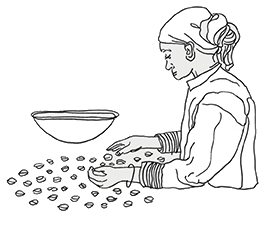About Bensa Shentawene
Ethiopia’s Sidamo region is one of the best-known coffee-producing regions in the world. Like the rest of Ethiopia, it’s divided into several woredas (districts) and kebeles (communities) with washing stations throughout—each offering unique terroir. The Bensa woreda is one of them, and within it lies the Shentawane kebele.
To get to Bensa we have to fly to the capital of Ethiopia, Addis Ababa, then take a local flight to Hawassa. The next leg of the journey to Bensa is 3 hours via car. There, we find the central washing station in Shentawane called Ayla.
The washing station is supply by 725 farmers, because the terrain is so rugged, travel time for producers throughout Bensa is often the same whether walking (typically transporting coffee via mule) or going by truck: approximately an hour.
Shentawane producers’ main income source is coffee, which they grow on very small farms ranging from 0.1 to 2 hectares. They usually intercrop with false banana trees for shade. Fertilization rarely happens in this area, although the soil is naturally very rich.
In the Ayla washing station the process starts with the selection of the cherries, then the cherries are immersed in a water tank to remove the floaters. Right after the floaters have been removed, cherries are de-pulped and fermented for 100 hours. Once fermentation completed, the parchments is laid on raised African beds under a parabolic shade net for 15 days. This coffee is part of an improved process project. In this process were introduced 100 hours (5 days) fermentation period. Every 24 hours the old water is changed with fresh cold water. Throughout the 5 days the fermentation is very slow at ambient temperature of 18.5-20.5 degree centigrade.
Since many farms are remote, access to clean water, electricity, and school for children is a constant challenge. That means children from the most distant farms often start working from a very young age. Opportunities are very few, but migrating to other cities is not a great option for young people in the area due to the large education gaps between their region and the city. Many young people decide to stay on their parents’ farms or buy neighboring farms and continue dedicating themselves to coffee for the rest of their lives.
The lack of opportunities is not the biggest problem in the area, in comparison with the cultivation of Khat (a commonly used stimulant in Africa) and Eucalyptus. Unfortunately, these crops are harmful to the environment due to their large consumption of water, which depletes the water table. Coffee, on the other hand, is native to the forests of Ethiopia and can have a forest-protective effect.
There are still producers in Shentawene who value coffee and want to preserve their ancient agricultural knowledge for generations to come. Those in the area who want to persevere in coffee find enthusiastic buyers for their elite product at Red Fox. This market access is crucial for the survival of coffee in Shentawene and probably one of the few factors that limits the destructive production of khat and eucalyptus in the area.

